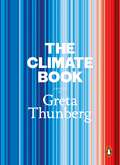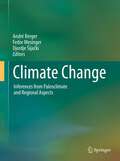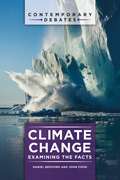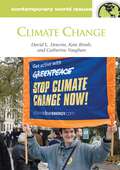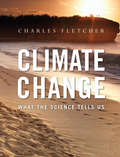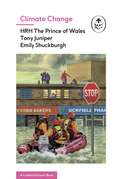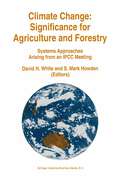- Table View
- List View
Climate and the Oceans (PDF)
by Geoffrey K. VallisThe oceans exert a vital moderating influence on the Earth's climate system. They provide inertia to the global climate, essentially acting as the pacemaker of climate variability and change, and they provide heat to high latitudes, keeping them habitable. Climate and the Oceans offers a short, self-contained introduction to the subject. This illustrated primer begins by briefly describing the world's climate system and ocean circulation and goes on to explain the important ways that the oceans influence climate. Topics covered include the oceans' effects on the seasons, heat transport between equator and pole, climate variability, and global warming. The book also features a glossary of terms, suggestions for further reading, and easy-to-follow mathematical treatments. Climate and the Oceans is the first place to turn to get the essential facts about this crucial aspect of the Earth's climate system. Ideal for students and nonspecialists alike, this primer offers the most concise and up-to-date overview of the subject available. The best primer on the oceans and climate Succinct and self-contained Accessible to students and nonspecialists Serves as a bridge to more advanced material
Climate and Water: Transboundary Challenges in the Americas (Advances in Global Change Research #16)
by Barbara J. Morehouse Henry F. DiazClimate and Water: Transboundary Challenges in the Americas explores some of the ways that climate, hydrology, and water resource management converge at the borders between jurisdictions and countries in the western Hemisphere. This book is unique in focusing on case studies of climate-hydrology-water resource management in diverse contexts in South, Central, and North America. This book is singular in highlighting important problems arising from the very existence of boundaries drawn and defined by society. Addressing such problems takes on increasing urgency as the world becomes ever more inter connected and interdependent. Target groups for this book include water resource managers and decision makers at levels from the international to the local; scientists involved in interdisciplinary studies of basic and applied climatology, hydrology, and environmental studies; and readers specializing in institutional analyses, including transboundary water law, policy analysis, and risk assessment. This book is also a useful text for college classes addressing natural resources management in general, and the transfer of scientific knowledge to society.
Climate and Weather (Collins New Naturalist Library #115)
by John KingtonReviewing the history and causes of climatic change and evaluating regional models, this New Naturalist volume offers an important analysis of climatic variations.
Climate and Weather of the Sun-Earth System: Highlights from a Priority Program (Springer Atmospheric Sciences)
by Franz-Josef LübkenCAWSES (Climate and Weather of the Sun-Earth System) is the most important scientific program of SCOSTEP (Scientific Committee on Solar-Terrestrial Physics). CAWSES has triggered a scientific priority program within the German Research Foundation for a period of 6 years. Approximately 30 scientific institutes and 120 scientists were involved in Germany with strong links to international partners. The priority program focuses on solar influence on climate, atmospheric coupling processes, and space climatology.This book summarizes the most important results from this program covering some important research topics from the Sun to climate. Solar related processes are studied including the evolution of solar radiation with relevance to climate. Results regarding the influence of the Sun on the terrestrial atmosphere from the troposphere to the thermosphere are presented including stratospheric ozone, mesospheric ice clouds, geomagnetic effects, and their relevance to climate. Several chapters highlight the importance of coupling mechanisms within the atmosphere, covering transport mechanisms of photochemically active species, dynamical processes such as gravity waves, tides, and planetary waves, and feedback mechanisms between the thermal and dynamical structure of the atmosphere. Special attention is paid to climate signals in the middle and upper atmosphere and their significance relative to natural variability.
Climate Atlas of the Atlantic Ocean: Derived from the Comprehensive Ocean Atmosphere Data Set (COADS)
by Ralf LindauThe presented climate atlas follows with regard to structure and vol ume the Bunker Climate Atlas of the North Atlantic Ocean published 1985 by H.-J. Isemer and L. Hasse, which has become a standard work for the climate study community. A new edition was appropriate, since during the last decade much progress was achieved in the correct interpretation of the wind speed reported by merchant ships. As the wind speed is an essential parameter for the fundamental air-sea interactions, namely the exchange of momentum and energy between ocean and atmosphere, considerable impact on resulting climate key parameters as Sverdrup transport or meridional heat transport could be expected. Furthermore, individual ship observations are nowadays available from COADS, the Comprehensive Ocean Atmosphere Data Set, and, due to the grown computer power, these data are processable in reasonable time. Thus, improving the calculations of air-sea fluxes, as performed by Isemer and Hasse, is no longer a complex and tricky venture, since flux parameterizations can be applied directly to the ship observations. Compared to the Bunker Altas we expanded the considered sea area and included also the South Atlantic. Considering the entire Atlantic Ocean reveals not only interesting features of the southern hemisphere but allows also a finer assessment of the resulting energy fluxes.
The Climate Book: The Facts And The Solutions
by Greta Thunberg*A Times, Financial Times, Observer and Nature Book of the Year*‘Spectacular ... this work is planetary in scale’ Independent‘It offers real, rich hope’ Observer, Books of the YearWe still have time to change the world. From the world's leading climate activist, this is the essential book for making it happen.Created by Greta Thunberg in partnership with over 100 climate experts working around the globe, with her commentaries throughout and updates for this new paperback edition to reflect the latest research, The Climate Book equips us with knowledge, and gives us hope. Together, it shows, we can do the seemingly impossible. But it has to be us, and it has to be now.
Climate Champions: The Work They Do and the People We Need (Women in Engineering and Science)
by Anna KellyIn this groundbreaking work, readers will discover a wealth of innovative and impactful advancements in the field of climate change. A call to action for those working to arrest or mitigate the impacts of this global crisis, this book showcases the tireless dedication of a workforce committed to creating a better world. Despite the despair and anger that often accompany discussions of climate change, this book offers a refreshing perspective by highlighting the moments of hope and pride that arise when individuals see their efforts have tangible, measurable impacts. Readers will also be inspired to learn that they don't have to be scientists or engineers to make a difference. The author illustrates how every person with an interest in protecting the environment, the global food supply, and geopolitical stability can join the fight, whether by improving the efficiency of manufacturing operations or by contributing to the manufacture of life-saving medicines. This is a must-read for anyone who cares about the environment, our global community, and our collective future.
Climate Change: Inferences from Paleoclimate and Regional Aspects
by André Berger, Fedor Mesinger and Djordje ŠijačkiExperts in climate and water sciences from Canada, the United States, Brazil, Denmark, Germany, Belgium, France, Serbia, and other European countries and the UNESCO gathered at the Serbian Academy of Sciences and Arts on the occasion of the 130th birthday anniversary of the geophysicist Milutin Milankovitch. The collection of their presentations is opened by an update on the climate situation after the Fourth Assessment Report of the Intergovernmental Panel on Climate Change. Further topics include various issues of paleoclimatology, in particular as it helps reduce uncertainties from which prospects for climate change suffer; ecohydrology and climate change at the watershed scale; and regional climate models, which are discussed in terms of both their improved modeling and their use in studies of a polynya in the Antarctica and expected changes in the Mediterranean region.
Climate Change: The Social and Scientific Construct
by Suhaib A. BandhBeginning in the second half of the twentieth century, the impacts of climate change have been fierce, causing loss of human life and irreparable destruction to natural and man-made infrastructure in many parts of the world.The difference between climate change now and in the past is that of sudden and disproportionate disruption of the natural energy dynamics by the changing consumption patterns of billions of human beings who have polluted terrestrial and aquatic ecosystems. The picture that emerges from the exhaustive analysis of international data drawn from the most reliable sources indicates that we have possibly gained access to the gateway of extinction and it is time that we take corrective steps immediately.Global climate change is further altering our relationship with the environment, modifying relatively stable climatic factors and making them uncertain, unpredictable, and threatening. Changes in land use and an increasing demand for water resources due to climate change have affected the capacity of ecosystems to sustain food production, ensure the supply of freshwater resources, provide ecosystem services, and promote rural multi-functionality. Ensuring food production does not just depend on increasing water efficiency, promoting climate resilient crop production, or reducing land-use competition for urbanization but also on a more suitable and stable climate as the changes in climatic factors like precipitation, temperature, radiation, evaporation, and wind bring about some major shifts in global food supplies. According to Special Report on Emission Scenarios (SRES), focused on greenhouse gas emissions projections, and Representative Concentration Pathways (RCPs) conducted by the Intergovernmental Panel on Climate Change (IPCC), climate change increases the risk of simultaneous crop failures (including corn, rice, legumes, and vegetables) if irrigation systems are not fully adapted to water stress situations. A changing climate could have many adverse impacts on other sectors of our environment. This book offers concrete, up-to-date, and appropriate study cum research material for students, researchers, academicians and policymakers. It will be of a greater interest to students and researchers in the field of environmental science, agriculture science, agronomy, and sustainable development.
Climate Change: Examining the Facts (Contemporary Debates)
by Daniel Bedford John CookClimate change is one of the most controversial and misunderstood issues of the 21st century. This book provides a clear understanding of the issue by presenting scientific facts to refute falsehoods and misinformation—and to confirm the validity of other assertions.Is public understanding of global warming suffering from politically biased news coverage? Is it true that the global scientific community has not reached a consensus on whether humans are causing climate change? This important book addresses these questions and many more about global warming, identifying common claims about climate change and using quantifiable, evidence-based information to examine their veracity.The authors of this work examine 35 specific claims that have been made about global climate change by believers and skeptics. These assertions—some true, some false—will guide readers to a much deeper understanding of the extent of climate change; whether any climate change that is taking place is human-caused; whether climate change is likely to be a serious problem in the future; whether scientists agree on the fundamentals of climate change; and whether climate change impacts can be mitigated. Examples of specific issues that are scrutinized and explained in the book include: trends in the extent and condition of Arctic and Antarctic Sea ice packs, the accuracy of climate forecasting models, whether extreme weather events are increasing as a result of climate change, and the benefits and drawbacks of various schemes to limit greenhouse gas emissions.
Climate Change: Examining the Facts (Contemporary Debates)
by Daniel Bedford John CookClimate change is one of the most controversial and misunderstood issues of the 21st century. This book provides a clear understanding of the issue by presenting scientific facts to refute falsehoods and misinformation—and to confirm the validity of other assertions.Is public understanding of global warming suffering from politically biased news coverage? Is it true that the global scientific community has not reached a consensus on whether humans are causing climate change? This important book addresses these questions and many more about global warming, identifying common claims about climate change and using quantifiable, evidence-based information to examine their veracity.The authors of this work examine 35 specific claims that have been made about global climate change by believers and skeptics. These assertions—some true, some false—will guide readers to a much deeper understanding of the extent of climate change; whether any climate change that is taking place is human-caused; whether climate change is likely to be a serious problem in the future; whether scientists agree on the fundamentals of climate change; and whether climate change impacts can be mitigated. Examples of specific issues that are scrutinized and explained in the book include: trends in the extent and condition of Arctic and Antarctic Sea ice packs, the accuracy of climate forecasting models, whether extreme weather events are increasing as a result of climate change, and the benefits and drawbacks of various schemes to limit greenhouse gas emissions.
Climate Change: An Interdisciplinary Introduction
by Thomas BrewerThis textbook introduces and explains the issues around climate change and its mitigation. It includes topics across disciplines and can be used as a single-volume text by students studying a range of subjects. Among the topics included are: ·How to adopt significant mitigation measures now to avoid the most catastrophic long-term consequences of climate change.·Reducing the rates of highly potent, short-lived emissions of methane gas and black carbon particulates—reductions that are necessary to meet the temperature targets of the Paris Agreements.·Implementing wide-ranging adaptation measures to reduce the deaths and economic costs of extreme heat waves, droughts, wildfires, hurricanes, and floods.·Recognizing the unusually rapid warming in the Arctic, which is disrupting weather patterns in the northern hemisphere and currents in the Atlantic Ocean, causing world-wide sea-level rise, and also causing methane leaks in the Arctic region—leaks that could eventually lead to irreversible global warming consequences. Meeting these challenges effectively requires action by both governments and businesses. The book examines the national and local governmental policies—and business practices—that are needed in sector-specific chapters. An objective of the book is to inform readers about specific problems resulting from climate change—and the wide range of potential government policies and business practices, changes in technologies, and changes in public attitudes and actions that can reduce the emissions and otherwise lessen their impacts. Indeed, a central message is that understanding the issues posed by climate change requires no less than an understanding of climate science, micro- and macro-economics, technologies for mitigation and adaptation measures, as well as politics and law at many governmental levels from local to global. The author has included short case studies that illustrate and integrate multiple analytic perspectives. The book is therefore appropriate for students, professionals, and general audiences with wide-ranging interests and backgrounds.
Climate Change: A Multidisciplinary Approach (PDF)
by William James BurroughsProviding a concise, up-to-date presentation of current knowledge of climate change and its implications for society as a whole, this new edition has been thoroughly updated and extended to include the latest information. The text describes the components of the global climate, considers how the many elements of climate combine to define its behaviour, and reviews how climate change is measured. The author discusses how the causes of climate change can be related to the evidence of change, and modelled to predict future changes. This book is ideally suited for introductory courses in meteorology, oceanography, environmental science, earth science, geography, agriculture and social science. It contains review questions at the end of each chapter to enable readers to monitor their understanding of the materials covered. This book should appeal to an audience with a keen interest in all aspects of the climate change debate.
Climate Change: A Reference Handbook (Contemporary World Issues)
by David Downie Kate Brash Catherine VaughanAn accessible introduction to climate change that outlines key scientific, economic, and political issues, reviews how the global community has addressed the issue to date, and discusses the options being explored for further action.Climate Change: A Reference Handbook offers readers a way to separate science from politics on this crucial and often contentious issue. It provides a comprehensive introduction to the science and public policy of climate change, including discussion of historical developments, today's key concepts, and the future of climate science and policy.Climate Change begins by explaining the science behind global climate change, including the growing consensus that human activity is a major contributing factor. It then takes an objective look at the key conflicts in climate science and policy, describes those that have been resolved, and offers a balanced review of proposals for those that have not. A separate chapter focuses on the scientific, economic, and political aspects of climate change as they are playing out specifically in the United States.
Climate Change: What the Science Tells Us
by Charles FletcherFletcher’s 1st edition of Climate Change includes information on geology, geography and environmental science. It covers contemporary topics as well as conveys more abstract concepts clearly. Fletcher offers the first real textbook to present the science and policy surrounding climate change at the right level for an undergraduate student. His polished writing style makes this an entertaining read while the pedagogical support and organization helps students better identify and understand key concepts, ideas and terms.
Climate Change: What the Science Tells Us
by Chip FletcherThis book introduces climate change fundamentals and essential concepts that reveal the extent of the damage, the impacts felt around the globe, and the innovation and leadership it will take to bring an end to the status quo. Emphasizing peer-reviewed literature, this text details the impact of climate change on land and sea, the water cycle, human communities, the weather, and humanity's collective future. Coverage of greenhouse gases, oceanic and atmospheric processes, Pleistocene and Holocene paleoclimate, sea levels, and other fundamental topics provide a deep understanding of key mechanisms, while discussion of extreme weather, economic impacts, and resource scarcity reveals how climate change is already impacting people's lives-and will continue to do so at an increasing rate for the foreseeable future.
Climate Change: What the Science Tells Us (PDF)
by Chip FletcherThis book introduces climate change fundamentals and essential concepts that reveal the extent of the damage, the impacts felt around the globe, and the innovation and leadership it will take to bring an end to the status quo. Emphasizing peer-reviewed literature, this text details the impact of climate change on land and sea, the water cycle, human communities, the weather, and humanity's collective future. Coverage of greenhouse gases, oceanic and atmospheric processes, Pleistocene and Holocene paleoclimate, sea levels, and other fundamental topics provide a deep understanding of key mechanisms, while discussion of extreme weather, economic impacts, and resource scarcity reveals how climate change is already impacting people's lives-and will continue to do so at an increasing rate for the foreseeable future.
Climate Change: Environmental And Social Impacts Of Large-scale Tropical Reforestation In Response To Global Climate Change (The Ladybird Expert Series)
by HRH The Prince of Wales Tony Juniper Emily ShuckburghPart of the new Ladybird Expert series, Climate Change is a clear, simple and enlightening introduction to one of the most important issues facing our world today.From HRH The Prince of Wales, environmentalist Tony Juniper and climate scientist Dr Emily Shuckburgh, it explains the history, dangers and challenges of global warming and explores possible solutions with which to reduce its impact. You'll learn about the causes and consequences of climate disruption; heatwaves, floods and other extreme weather; disappearing wildlife; acid oceans; the benefits of limiting warming; sustainable farming, new clean technologies and the circular economy.Written by the leading lights and most outstanding communicators in their fields, the Ladybird Expert books provide clear, accessible and authoritative introductions to subjects drawn from science, history and culture.Other books currently available in the Ladybird Expert series include:· Quantum Mechanics· EvolutionFor an adult readership, the Ladybird Expert series is produced in the same iconic small hardback format pioneered by the original Ladybirds. Each beautifully illustrated book features the first new illustrations produced in the original Ladybird style for nearly forty years.
Climate Change (Key Ideas in Geography)
by Mike HulmeWritten by a leading geographer of climate, this book offers a unique guide to students and general readers alike for making sense of this profound, far-reaching, and contested idea. It presents climate change as an idea with a past, a present, and a future. In ten carefully crafted chapters, Climate Change offers a synoptic and inter-disciplinary understanding of the idea of climate change from its varied historical and cultural origins; to its construction more recently through scientific endeavour; to the multiple ways in which political, social, and cultural movements in today’s world seek to make sense of and act upon it; to the possible futures of climate, however it may be governed and imagined. The central claim of the book is that the full breadth and power of the idea of climate change can only be grasped from a vantage point that embraces the social sciences, humanities, and natural sciences. This vantage point is what the book offers, written from the perspective of a geographer whose career work on climate change has drawn across the full range of academic disciplines. The book highlights the work of leading geographers in relation to climate change; examples, illustrations, and case study boxes are drawn from different cultures around the world, and questions are posed for use in class discussions. The book is written as a student text, suitable for disciplinary and inter-disciplinary undergraduate and graduate courses that embrace climate change from within social science and humanities disciplines. Science students studying climate change on inter-disciplinary programmes will also benefit from reading it, as too will the general reader looking for a fresh and distinctive account of climate change.
Climate Change: A Case Against Climate Engineering (Key Ideas in Geography)
by Mike HulmeWritten by a leading geographer of climate, this book offers a unique guide to students and general readers alike for making sense of this profound, far-reaching, and contested idea. It presents climate change as an idea with a past, a present, and a future. In ten carefully crafted chapters, Climate Change offers a synoptic and inter-disciplinary understanding of the idea of climate change from its varied historical and cultural origins; to its construction more recently through scientific endeavour; to the multiple ways in which political, social, and cultural movements in today’s world seek to make sense of and act upon it; to the possible futures of climate, however it may be governed and imagined. The central claim of the book is that the full breadth and power of the idea of climate change can only be grasped from a vantage point that embraces the social sciences, humanities, and natural sciences. This vantage point is what the book offers, written from the perspective of a geographer whose career work on climate change has drawn across the full range of academic disciplines. The book highlights the work of leading geographers in relation to climate change; examples, illustrations, and case study boxes are drawn from different cultures around the world, and questions are posed for use in class discussions. The book is written as a student text, suitable for disciplinary and inter-disciplinary undergraduate and graduate courses that embrace climate change from within social science and humanities disciplines. Science students studying climate change on inter-disciplinary programmes will also benefit from reading it, as too will the general reader looking for a fresh and distinctive account of climate change.
Climate Change (Eco Alert #2)
by Rebecca HunterIn Climate Change find out how the climate on Earth is changing. What causes global warming? How has Earth's climate changed in the past? What will happen if the world does get warmer? Can we reverse this process?
Climate Change -: Environment and History of the Near East
by Arie S. Issar Mattanyah ZoharThis survey of the ancient levels of lakes, rivers and the sea, as well as changes in the compositions of stalagmites and sediments reveals an astonishing correlation of climate changes with the emergence and collapse of civilizations in the Middle East. The authors conclude that climate change has been the decisive factor in the history surrounding the origins of the "cradle of civilization".
Climate Change: Systems Approaches Arising from an IPCC Meeting
by S. MarkHowden David H. WhiteSocieties throughout the world depend on food, fiber and forest products. Continuity and security of agricultural and forest production are therefore of paramount importance. Predicted changes in climate could be expected to alter, perhaps significantly, the levels and relative agricultural and forestry production of different nations over the next few decades. Agriculture and forestry are also likely to influence the rate and magnitude of such change, as they can be both significant sources and sinks of a number of greenhouse gases. Adaptive management strategies therefore need to be formulated and implemented for these sectors, to enable them to both adapt to future environmental change, and to limit greenhouse gas emissions. This book arose from an international workshop held in Canberra, Australia, under the auspices of the former IPCC Working Group III - Agriculture, Forestry and Other Human Activities Sub-Group (AFOS). A number of leading speakers at the workshop were approached to encapsulate the concepts discussed and developed at this workshop. The resulting papers make up this volume. The book promotes a greater understanding of the major sources and sinks of greenhouse gases within intensive and extensive cropping and animal production systems, and of agroforestry. It highlights the need to adopt a holistic systems approach to monitoring and reducing greenhouse gas emissions and assessing impacts, and to integrate climate change-related goals and activities with other issues, such as biodiversity, desertification, and sustainable agriculture and forestry.
Climate Change: Past, Present, and Future
by Marie-Antoinette Mélières Chloé MaréchalThis book is designed for first- and second-year university students (and their instructors) in earth science, environmental science, and physical geography degree programmes worldwide. The summaries at the end of each section constitute essential reading for policy makers and planners. It provides a simple but masterly account, with a minimum of equations, of how the Earth’s climate system works, of the physical processes that have given rise to the long sequence of glacial and interglacial periods of the Quaternary, and that will continue to cause the climate to evolve. Its straightforward and elegant description, with an abundance of well chosen illustrations, focuses on different time scales, and includes the most recent research in climate science by the United Nations Intergovernmental Panel on Climate Change (IPCC). It shows how it is human behaviour that will determine whether or not the present century is a turning point to a new climate, unprecedented on Earth in the last several million years.
Climate Change: Past, Present, and Future
by Marie-Antoinette Mélières Chloé MaréchalThis book is designed for first- and second-year university students (and their instructors) in earth science, environmental science, and physical geography degree programmes worldwide. The summaries at the end of each section constitute essential reading for policy makers and planners. It provides a simple but masterly account, with a minimum of equations, of how the Earth’s climate system works, of the physical processes that have given rise to the long sequence of glacial and interglacial periods of the Quaternary, and that will continue to cause the climate to evolve. Its straightforward and elegant description, with an abundance of well chosen illustrations, focuses on different time scales, and includes the most recent research in climate science by the United Nations Intergovernmental Panel on Climate Change (IPCC). It shows how it is human behaviour that will determine whether or not the present century is a turning point to a new climate, unprecedented on Earth in the last several million years.





